Onsen etiquette explained
The luxury of soaking in natural hot springs known as onsen often takes high priority for both domestic and international travelers in Japan when planning a trip. Whether just making a short visit to bathe after a day of adventures or staying for a few days at an onsen resort town, the mineral rich waters are sure to refresh and relax visitors.
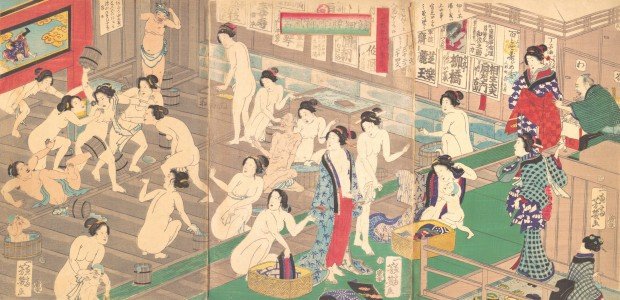 Looks like an interesting time at the onsen! A fight breaking out in “Interior of a Public Bath” by Utagawa Yoshiiku. Woodblock triptych from the 19th century. Image: Metropolitan Museum of Art
Looks like an interesting time at the onsen! A fight breaking out in “Interior of a Public Bath” by Utagawa Yoshiiku. Woodblock triptych from the 19th century. Image: Metropolitan Museum of Art
The unique experience of communal bathing and “hadaka no tsukiai” (meaning naked communion) also draw in bathers. Yet, for those seeking the Japanese onsen or sento experience for the first time though, especially from cultures where bathing tends to be a private ritual performed alone, the no clothing, no swimsuit rule at the majority of onsen can prove daunting. In addition, not knowing what to do in an onsen and wandering around stark naked does not seem ideal.
In order to assuage any fears, we have compiled a guide on onsen and sento etiquette so you will know what to expect. Whether it is a first-time plunge or you have visited onsen a few times, this step-by-step outline will ensure that you make the most of your onsen experience from here on out! We will use some woodblock prints from the Edo period (1603-1868) to help illustrate the world of onsen, though of course modern day onsen have had some upgrades since then, like plumbing and faucets. As the anthropologist Scott Clark explained in his book “Japan: A View from the Bath,”
Stepping into the world of onsen… but which entrance?!
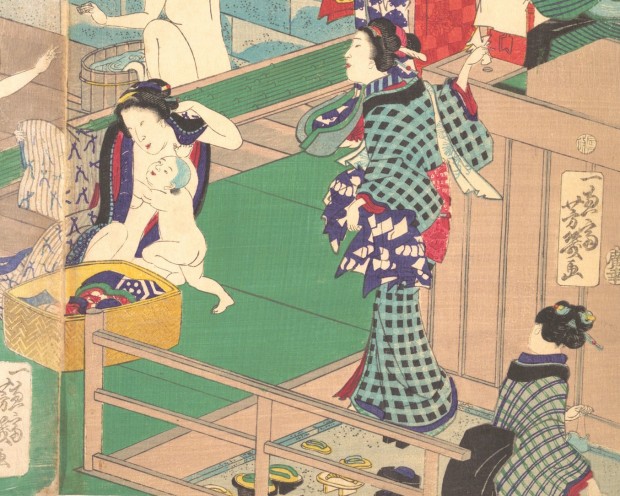
After removing your shoes at the entrance, you will proceed either to the baths or to a ticket counter to pay beforehand depending on the facility. At most places, you will be given two towels: a smaller-sized, long washcloth for washing and a larger bath towel for drying.
Most onsen separate spaces used by males and females, so be sure to enter the appropriate bath. Look for hanging fabric dividers with a vertical slit called noren. The noren cloth for males will typically be blue or a deep purple and marked with the kanji character, 男. Conversely, the female entrance will be adorned with a reddish noren and the character, 女. Sometimes the areas are switched, so the bath you entered yesterday could now be for members of the opposite sex today.
Liberating the body, from clothes and more
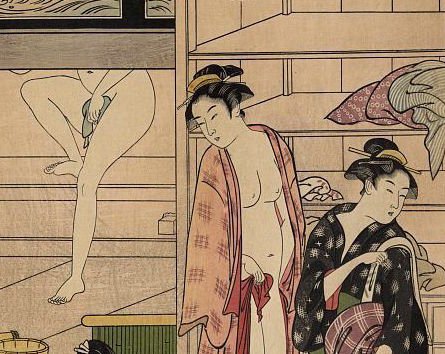
Once passing through the noren, you have entered the changing room – you are one step closer to the baths! Now comes the big test for first-time onsen-goers – taking off the clothes. Don’t let some nudity force you to give up yet though! You will notice that people of all ages come to the onsen, and no one seems the least bit fazed. Nakedness strips us down to our most basic self, and you are free to feel comfortable in your own skin in the baths. Also, remember that smaller-sized towel you were handed? You can use that to partially cover yourself while walking between baths or through the dressing room. The point is to feel relaxed in the hot baths so there is no need to obsess over the nudity.
One word of caution
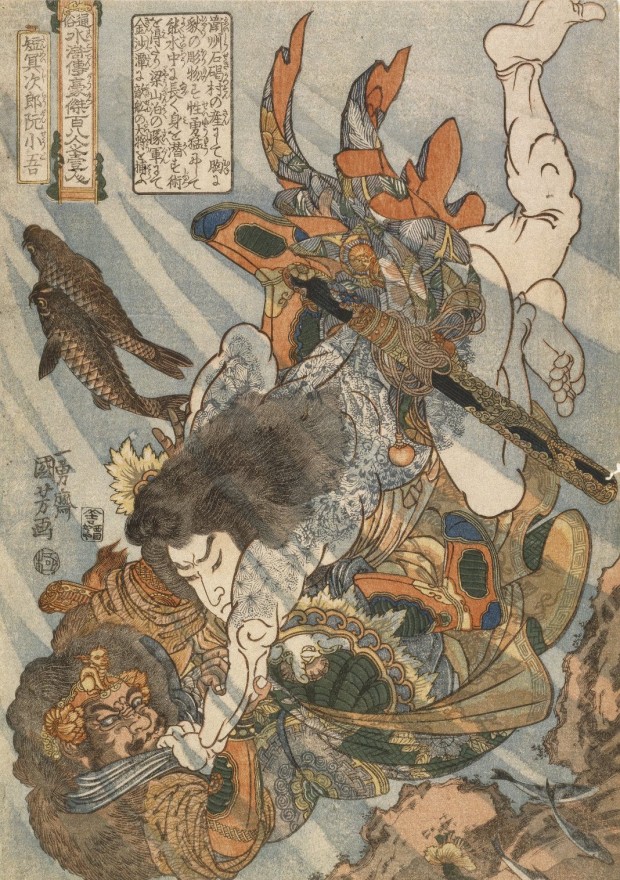 Tammeijiro Genshogo woodblock print by Utagawa Kuniyoshi produced between 1820-26. Image: Brooklyn Museum
Tammeijiro Genshogo woodblock print by Utagawa Kuniyoshi produced between 1820-26. Image: Brooklyn Museum
One note however, if you have tattoos, you may or may not be able to enter the onsen. Tattoos were associated with Japanese yakuza gangs and though some establishments are more lenient nowadays, especially to foreigners, those with large tattoos may still find some challenges. Small tattoos can be covered with band-aids or medical tape, and it may be best to prepare this part before going to the onsen.
Remove all clothing items and accessories and store them in the provided lockers, shelves, or baskets. You have come so far, it is almost time to soak in all the onsen glory! Before heading to the bath area, do not forget to bring the smaller wash towel, a hair tie if you have mid to long-length hair, or any shampoo and soaps you brought yourself. (Most onsen provide shampoo, conditioner labeled as rinse, and body soap though, so it is not necessary to bring your own.) If you don’t plan to wash your hair, bring a shower cap along. Now that you have all your supplies, it is time to finally set foot into the bath area.
Beyond the steam and to the showers! Washing before bathing
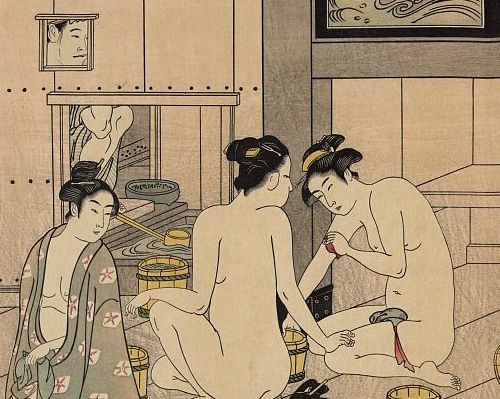 Wash your body before entering the steaming baths. Thankfully, nowadays you can get your water from a tap and shower head instead of a bath worker. A portion of the woodblock print, “Bathhouse Women” by Torii Kiyonaga (1752-1815).
Wash your body before entering the steaming baths. Thankfully, nowadays you can get your water from a tap and shower head instead of a bath worker. A portion of the woodblock print, “Bathhouse Women” by Torii Kiyonaga (1752-1815).
Upon leaving the locker area and through the steamy doors to the bath, you will discover a row or rows of shower stations. Though you may be tempted to step into the bath first, onsen etiquette dictates that you cleanse yourself thoroughly first before sharing the bath with your fellow onsen-goers. Do not skip this step and head to the shower stations. Each one comes equipped with a handheld shower head, a tap often operated with a push button, a stool, and a basin or bucket. Claim your spot and start washing yourself thoroughly from head to toe. Once finished, tie up your hair, wring out your wash towel, and set your shampoo items on the provided shelf area.
Soaking in the onsen
The best part comes now. Step into the steaming tub of your choice and relax. Most onsen have at least one inside and one outside bath called a rotenburo, which can be an excellent option after one gets a little too warm. The fresh air outside helps keep you from feeling like a boiled lobster. As you go between the various baths, do not forget to bring your little towel with you. It should not touch the bath water, so place it on or tie it around your head, or set it beside the bath.
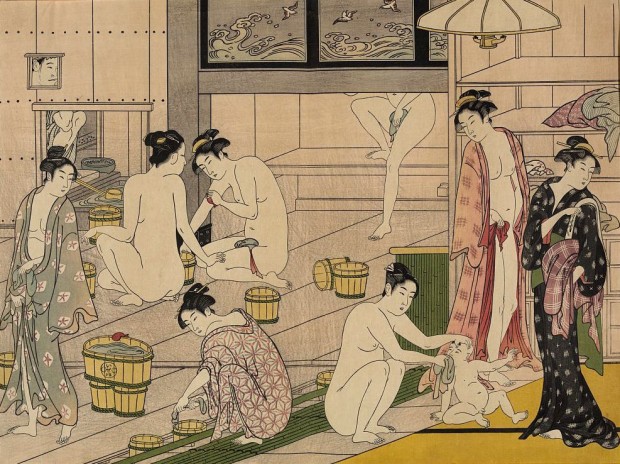 A bath scene is depicted in this woodblock print, “Bathhouse Women” by Torii Kiyonaga. Image:
A bath scene is depicted in this woodblock print, “Bathhouse Women” by Torii Kiyonaga. Image:
Library of Congress
Onsen use natural hot springs and the water contains a variety of minerals. As a result, you may encounter some water that is milky or cloudy in appearance, colored, or has a slightly silky or sticky feel. In some cases, the water may be carbonated or have herbs added as well. These unique onsen waters are believed to benefit the skin and body, so enjoy pampering and allow the onsen to work its magic.
Speaking of pampering, some of the fancier onsen will also include saunas, body scrub sessions called akasuri, massage jet baths, mist rooms, and dry baths. While enjoying the different options, do not forget to keep yourself hydrated. Drinking water is generally provided, and you are allowed to bring bottled water or tea into the bath, too. Onsen waters can reach 40 to 44 degrees Celsius so take care about not spending too long in each bath to the point of becoming dizzy or overheated. If you feel a little too hot, sit half-submerged in the water or take a break.
Completing the onsen experience
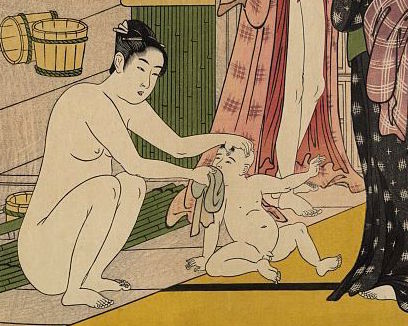
When you are ready to return to the changing room, lightly wipe down your body with the small wash towel to prevent yourself from dripping water all over the floor. Once you are back inside, use the larger bath towel to dry yourself thoroughly before putting on your clothes, or the provided yukata or robe.
At one end of the locker room should be an area with hair dryers and spaces to apply face creams or makeup for those interested. As you finish up and move around, you may notice that your body is extremely warm. Onsen are beneficial in relaxing muscles and improving blood circulation. Enjoy the post-onsen glow and indulge yourself in the often provided massage chairs or supplementary massage sessions. Finally, wrap up your onsen experience with the customary glass of cold milk! You may have seen vending machines selling milk on your way in, and now is the time to partake in the dairy beverage.
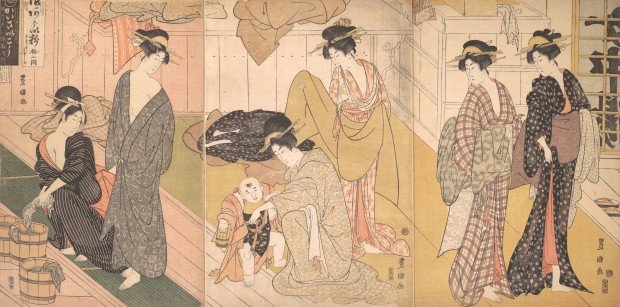 “Women and an Infant Boy in a Public Bath House” by Utagawa Toyokuni I from around 1799. In possession of the Metropolitan Museum of Art.
“Women and an Infant Boy in a Public Bath House” by Utagawa Toyokuni I from around 1799. In possession of the Metropolitan Museum of Art.
Now that you know what to anticipate, we hope you are feeling eager to try out or repeat the onsen experience. Happy bathing!
Written by Jennifer Myers.












